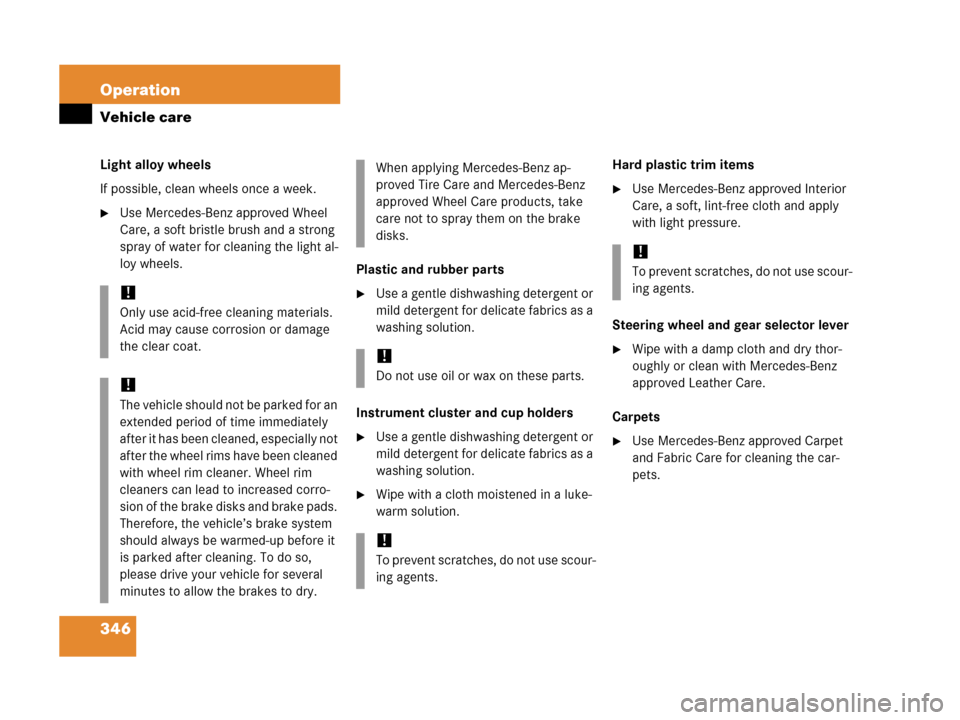Page 347 of 473

346 Operation
Vehicle care
Light alloy wheels
If possible, clean wheels once a week.
�Use Mercedes-Benz approved Wheel
Care, a soft bristle brush and a strong
spray of water for cleaning the light al-
loy wheels.
Plastic and rubber parts
�Use a gentle dishwashing detergent or
mild detergent for delicate fabrics as a
washing solution.
Instrument cluster and cup holders
�Use a gentle dishwashing detergent or
mild detergent for delicate fabrics as a
washing solution.
�Wipe with a cloth moistened in a luke-
warm solution.Hard plastic trim items
�Use Mercedes-Benz approved Interior
Care, a soft, lint-free cloth and apply
with light pressure.
Steering wheel and gear selector lever
�Wipe with a damp cloth and dry thor-
oughly or clean with Mercedes-Benz
approved Leather Care.
Carpets
�Use Mercedes-Benz approved Carpet
and Fabric Care for cleaning the car-
pets.
!
Only use acid-free cleaning materials.
Acid may cause corrosion or damage
the clear coat.
!
The vehicle should not be parked for an
extended period of time immediately
after it has been cleaned, especially not
after the wheel rims have been cleaned
with wheel rim cleaner. Wheel rim
cleaners can lead to increased corro-
sion of the brake disks and brake pads.
Therefore, the vehicle’s brake system
should always be warmed-up before it
is parked after cleaning. To do so,
please drive your vehicle for several
minutes to allow the brakes to dry.
When applying Mercedes-Benz ap-
proved Tire Care and Mercedes-Benz
approved Wheel Care products, take
care not to spray them on the brake
disks.
!
Do not use oil or wax on these parts.
!
To prevent scratches, do not use scour-
ing agents.
!
To prevent scratches, do not use scour-
ing agents.
Page 440 of 473

439 Technical data
Fuels, coolants, lubricants, etc.
In areas where carbon deposits may be
encountered due to lack of availability of
gasolines which contain these additives,
Mercedes-Benz recommends the use of
additives approved by us for use on
Mercedes-Benz vehicles. Refer to Factory
Approved Service Products pamphlet for a
listing of approved product(s). Follow
directions on product label.
Do not blend other fuel additives with fuel.
This only results in unnecessary cost and
may be harmful to engine operation.
Damage or malfunction resulting from
poor fuel quality or from blending
additional fuel additives other than those
tested and approved by us for use on
Mercedes-Benz vehicles listed in the
Factory Approved Service Products
pamphlet are not covered by the
Mercedes-Benz Limited Warranty. Fuel requirements
Only use premium unleaded fuel:
�The octane number (posted at the
p um p) m us t be 91 mi n. It i s an a vera ge
of both the Research (R) octane num-
ber and the Motor (M) octane number:
(R+M)/2. This is also known as the
ANTI-KNOCK INDEX.
Unleaded gasoline containing oxygenates
such as ethanol, IPA, IBA and TBA can be
used provided the ratio of any one of these
oxygenates to gasoline does not
exceed 10%; MTBE must not exceed 15%.
The ratio of methanol to gasoline must not
exceed 3% plus additional cosolvents.
Using mixtures of ethanol and methanol is
not allowed. Gasohol, which contains 10%
ethanol and 90% unleaded gasoline, can
be used.
These blends must also meet all other fuel
requirements, such as resistance to spark
knock, boiling range, vapor pressure, etc.
Coolants
The engine coolant is a mixture of water
and anticorrosion/antifreeze, which
provides:
�Corrosion protection
�Freeze protection
�Boiling protection (by increasing the
boiling point)
The cooling system was filled at the factory
with a coolant providing freeze protection
to approximately -22°F (-30°C) and
corrosion protection.
If the antifreeze mixture is effective
to -22°F (-30°C), the boiling point of the
coolant in the pressurized cooling system
is reached at approx. 266°F (130°C).
Page 445 of 473

444 Technical terms
CAN system
(C
ontroller Area Network)
Data bus network serving to control
vehicle functions such as door locking
or windshield wiping depending on
vehicle settings and/or ambient
conditions.
Cockpit
All instruments, switches, buttons and
indicator/warning lamps in the
passenger compartment needed for
vehicle operation and monitoring.
Cold tire inflation pressure
(
�page 331)
Collapsible tire
An especially compact spare tire that
must be inflated with a provided air
pump before using. It should only be
used to bring the vehicle to the nearest
service station.COMAND*
(C
ockpit Management and Data
System)
Information and operating center for
vehicle sound and communications
systems, including the radio and the
navigation system, as well as other
optional equipment (CD changer*,
telephone*, etc.).
Control system
The control system is used to call up
vehicle information and to change
component settings. Information and
messages appear in the multifunction
display. The driver uses the buttons on
the multifunction steering wheel to
navigate through the system and to
adjust settings.
Cruise control
Driving convenience system that
automatically maintains the vehicle
speed set by the driver.
Curb weight
(
�page 332)DOT
(D
epartment of Transportation)
(
�page 332)
Engine number
The number set by the manufacturer
and placed on the cylinder block to
uniquely identify each engine
produced.
Engine oil viscosity
Measurement for the inner friction
(viscosity) of the oil at different temper-
atures. The higher the temperature an
oil can tolerate without becoming thin,
or the lower the temperature it can
tolerate without becoming viscous, the
better the viscosity.
ESP
®
(Electronic Stability Program)
Improves vehicle handling and
directional stability.